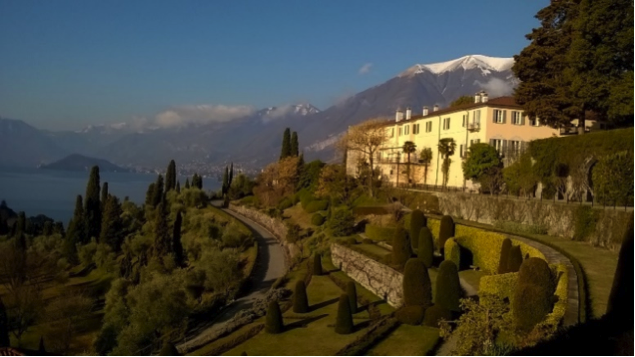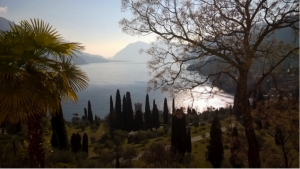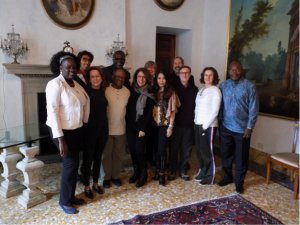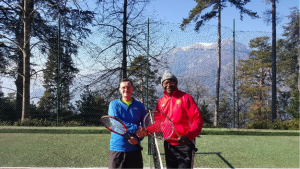
In this post Peter Littlejohns, deputy director of the CLAHRC and public health theme tells us about his time on the Rockefeller Foundation Bellagio Centre international residency programme. Peter used his residency to identify ways to stimulate the public to get more involved in difficult healthcare prioritisation decisions.
Early February saw me going up the meandering road leading to the 15th century Villa Serbelloni on Lake Como, Italy. This now houses the Rockefeller Foundation Bellagio Centre where they host their international residency programme.
I was one of fourteen 2018 academic residents who would be joining 36 practitioner and artistic residents for one-month periods throughout the year to “address some of the world’s most pressing challenges”. I was particularly pleased to see my CLAHRC South London project referred to in their press release “improving equitable access to health care”. For the month of February there were to be three academics, a visual artist, two authors, six practitioners and a film maker.
The Bellagio Centre is famous for its physical beauty, but also for the unique experience it offers its residents. By bringing together people of multiple backgrounds from all over the world they seek to create the gestalt in improving the lot of humanity. There is a regular daily routine – the residents share meals together and in between times work on their projects in their studies or studios. Whenever there are conferences in the two other buildings in the grounds making up the complex, the delegates (about 20) join the residents in the villa for dinner. Three conferences took place while I was there: on international surveillance systems to detect plant infections early, gender and social inclusion and how to extend access to electricity in developing countries. Where but Bellagio could you share meals with the CEO of Thomson Reuters Foundation, founder of the ‘stop slavery awards’ www.stopslaveryaward.com who is writing a book on modern slavery; the President of the Nelson Mandela Foundation who is writing a novel on modern South Africa inspired by the cull of the guard dogs after the fall of the Gulag Archipelago; and a visual artist exploring old and new migration patterns out of Africa utilising coats of arms and tapestry based on the Financial Times?
My project was to collate my CLAHRC South London research over the last four years and identify ways to stimulate the public to get more involved in difficult healthcare prioritisation decisions. While a monograph was the obvious option, I decided in the end to create an interactive website to engage the public directly. Much of the discussion with the other residents was centred on how to make writing (particularly scientific writing) more accessible to the reader. In these discussions (which occasionally overflowed into arguments, eg: ‘Can you really ever change?’ and ‘Are artists more creative than scientists?!’), I often referred to the approach taken by American surgeon, writer, and public health researcher, Atul Gawande. Atul’s work always draws on the evidence, but is usually introduced with an anecdote, invariably referring to himself or a family member. I can remember him giving a ‘dress rehearsal’ for his second Leith Lecture in the 2014 series at Guy’s Campus. The Greenwood Theatre was full of students and much less than usual numbers were engrossed in their phones – he had them mesmerised.
Atul demonstrated the power of stories. So my website is attempting to be more story-like and personal than most medical websites, but its aim is to encourage the general public to get involved by coming forward and telling their stories. Here is the prototype website https://people4health.com. We will see if by producing a number of health prioritisation case study films in New Zealand, Africa and Australia we can trigger others to do so and stimulate a dialogue about fairness in health care.
The Villa Serbelloni’s library holds all the books written by previous residents. My eye was caught by Nuala Kenny’s ‘What good is health care’, in which the Canadian physician, ethicist, and health manager rehearses all the arguments for fair prioritisation of health care. She highlights the key values for health reform – the traditional ones of solidarity and equity, compassion and efficiency, but adds ‘civility’, which she defines as the ability to discuss and decide as citizens. Nuala goes on to explore the profound difficulty in eliciting public values in a pluralistic society and calls for new tools – including a common space, a language and a process (page 209). I hope that our decision-making audit tool (DMAT) and new website will be part of that solution.
In the evenings residents would present their projects before dinner or, in the case of artists, their creations after dinner. Foremost in my memory was the story of Jane Thomas, a social anthropologist who had spent 30 years in conflict zones rebuilding communities destroyed by natural disasters. Jane’s last project was in Pakistan-administered Kashmir after the earthquakes of 2005, in which 87,000 people are estimated to have died. She explained how real community engagement was key to getting 77 schools rebuilt on time and on budget. They even initiated an annual book festival that attracted 25,000 visitors. The basis of Jane’s approach was two-way listening, but also by emphasising to the community that they, as well as the contractors, had responsibilities to deliver on their side of the bargain (which had been formalised into documented protocols). We have a lot to learn from this approach on how we can get meaningful patient and public involvement (PPI) into the current re-organisation of the NHS commissioning and service delivery structures. CLAHRC South London has a pivotal role in supporting the new PPI initiatives as they emerge and, most importantly, designing and implementing robust mixed-methods approaches to their evaluation.
When the Bellagio residents were not working, we would walk in the quintessential Italianate gardens, which also had the most picturesque tennis court I have ever seen. So, on the (very) occasional warm and sunny days a little international non-academic competitiveness was displayed. Unfortunately, a Professor of Literature from the Cameroons was too strong for a Professor of Public Health from Wales.




Leave a Reply